- How to Find the Best Hand Meat Grinder - January 23, 2022
- How to Find the Best Jerky Making Kit - January 23, 2022
- How to Find the Best Sheep Casings for Meat - October 24, 2021
Butchery has always been an essential part of the food industry. Today, we’ll look at the best butcher tools and meat processing equipment you can buy to cut meat on your own conveniently.
From buying your favorite cuts of steak to getting minced meat, we all visit a butcher to satisfy our culinary desires. For a butcher, the ultimate satisfaction is having the tools to precisely cut meat that customers will appreciate.
Let’s look at the history of butchery, how the tools have evolved, and what butcher tools and meat processing equipment are available on the market today.
Butchery Through the Years
Butchery is one of the oldest professions in the world that dates back thousands of years. The earliest hunters learned how to dissect meat using stones nearly 3.4 million years ago. AS we humans began to domesticate livestock, the skills and tools improved over time.
Butcher tools have changed a lot over the centuries. From sharpening a stone to skin an animal to using a skinning knife, and hanging carcasses from trees to using hooks and gambles. A lot has changed to keep up with the times and growing demand for meat.
It would take many hours to slaughter, cut down, and prepare meat varieties from cows and lambs in the past. Today, thanks to an array of butcher tools and meat processing equipment, this has become less time-consuming.
The industrial revolution brought a change in butchery, and the meat industry was formed (formally and informally) in different parts of the world. This led to the increasing use of machinery and equipment to process tons of meat daily to keep up with the growing demand.
Today, a butcher needs to have excellent interpersonal skills as he is responsible for customer service, supplier negotiations, and other aspects of dealings. In many cases, a butcher is not just preparing the meat but is also responsible for running the business, managing inventory, keeping records, and packing the meat.
Best Butcher Tools and Meat Processing Equipment
Whether you’re a hunter who wants to cut their game meat or an aspiring butcher, the right tools can significantly impact the result.
There are many types of butcher tools and meat processing equipment used to cut and process meat. Ranging from saws and knives to meat grinders and tenderizers, these tools make butchering easier for people like you and me. These tools are commonly made of stainless steel to minimize the risks of bacterial infections and rusting.
Let’s go through each type of equipment and explain what they do, the different kinds available on the market, and precaution and safety tips for each.
Knives

One of the most sought-after equipment you are ought to find at a butcher is the knife. Many different kinds of knives are available for carrying out other tasks of meat cutting.
- Boning knife: These are available in lengths from 5-6 inches and vary in flexibility. For general use, a semi-flexible boning knife does a good job. There are also straight and angled blade versions to make different types of cuts. I recommend going for one that fits your hands and has a slight texture on the handle to avoid slippage.
One of my favorite boning knives is the Mercer Culinary Millennia. It’s a tremendous 6-inch curved knife that offers ample flexibility and durability to match that.
- Scimitar: A scimitar is a non-flexible knife used to trim large pieces of meat into beef cubes, cutlets, and more. It is usually 10-16 inches in length. It is not advisable to use it for mining or chopping as it has a curved edge.
My personal favorite is the Swedish scimitar knife, the Victorinox Cimeter. It carries the brand’s legacy with durable construction, and the 12-inch blade makes it easy to turn large pieces of meat into small cubes quickly.
- Chef’s Knife: A chef’s knife is usually 8-10 inches in length and is used to trim, dice, chop, and mince large portions of meat. It is a bit heavy and cumbersome due to its width. As the name suggests, a chef’s knife is a very famous piece of equipment amongst chefs as it can be used for various things.
Almost all leading manufacturers make chef’s knives. For me, the most appealing choice is the PAUDIN Prp Kitchen Knife as it’s more ergonomic than most Chef’s knives out there.
- Slicer: Finally, a slicer is a 12-inch knife that typically comes in three models; stiff, semi-flexible, and flexible. It has a straight edge and is used in portion making and trimming significant cuts.
A slicer knife that we recommend is the DALSTRONG Phantom Series Carving Knife. It is made up of Japanese high carbon steel and also boasts a lifetime warranty on the blade.
Meat Cleaver
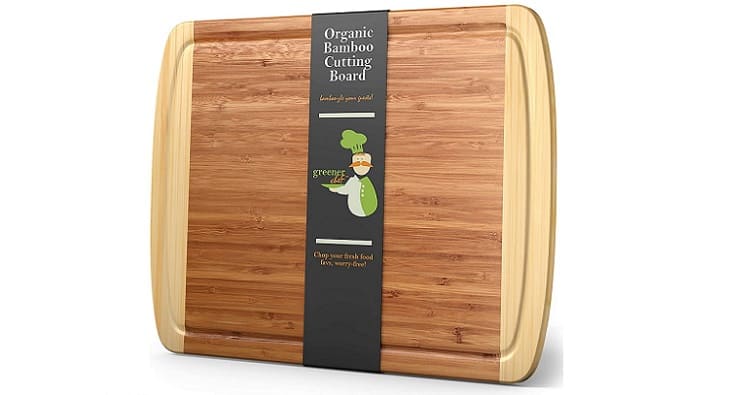
A meat cleaver is another essential part of the butcher’s arsenal. It’s essentially a heavy steel blade used to cut through large chunks of meat and bones. A meat cleaver is only used on a piece of log or a butcher’s block as they tend to absorb most of the shock of the cleaver.
Generic cutting boards tend to break when used with a cleaver, so make sure to get a good board or block. My recommendation would be to get the Organic Bamboo Cutting Board as it’s large enough and protects your knife from damage as well.
Cleavers come in many sizes, with the big sizes usually used for cutting beef or lamb. Smaller cleavers are typically used in making chicken.
The Mueller Cleaver is the market leader in making quality meat cleavers and has not compromised their quality. It has a heavy handle to balance the weight and is made of high-quality stainless steel for durability and longevity.
Meat Tenderizer
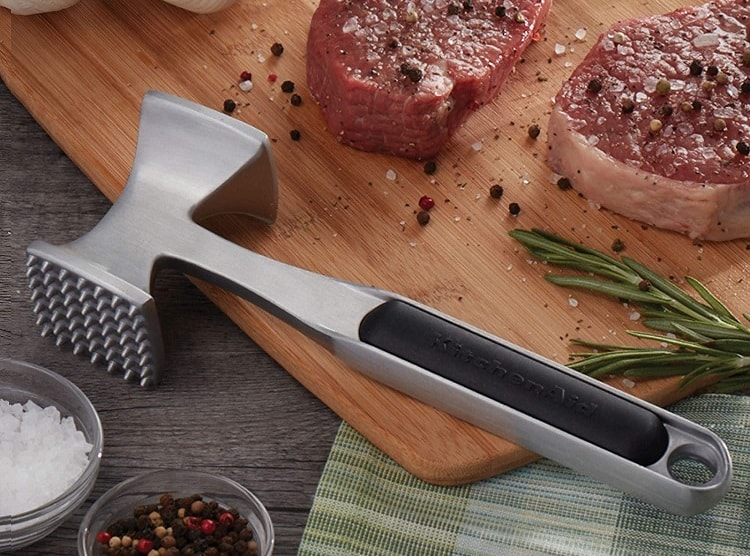
A meat tenderizer is a hammer with two distinct sides, one with small sharp blades and the other with a flattened side.
The blade side is used to hammer a tough cut of meat and break down the muscle fibers to release the juices of the meat. It helps cook the meat uniform and is juicy.
There are several blades that make pockets in the meat to retain juices within them making it juicer. The flattened side is used to flatten out a piece of chicken or meat to have a uniform thickness.
While you can’t go wrong with a meat tenderizer, the KitchenAid Meat Tenderizer has served me quite well over the years if you are looking for a recommendation. I’m not surprised that it’s one of the highest-rated meat tenderizers you can buy online.
Meat Saws
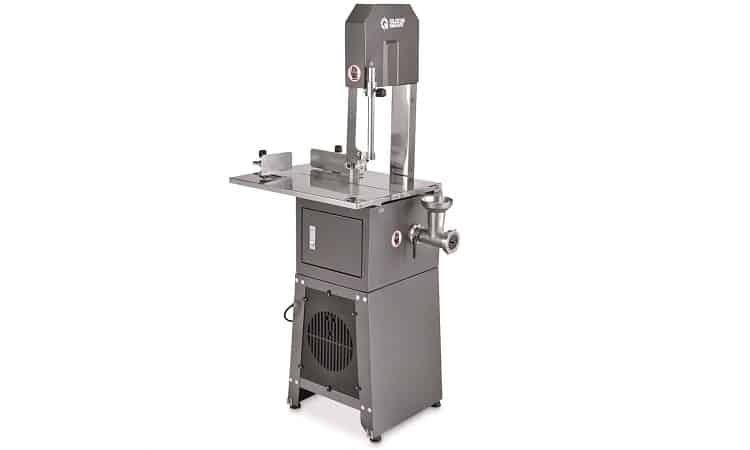
Meat saws are used to cut through thick portions of bones. There are two options in meat saws:
- Electric meat saws: These saws may not be available at your local butcher shop. They are used in bigger establishments where a large amount of meat is processed daily. The main advantage of an electrical saw is that it is faster than a manual saw. Electric saws can efficiently process large carcasses of buffalo, cows, deer, pigs, and more. They are more precise and can be operated at different speeds for the best results.
If you are looking for a fast, efficient, and durable meat saw, the Guide Gear electric saw is a great option. That said, you must be very careful when operating an electrical saw to avoid any major injuries.
- Manual meat saws: These saws are a lot slower than electric meat saws but are much cheaper too. If you are getting into butchery on your own or want to open a small shop, a manual saw can do a great job. Also, the precision of the manual saw depends on the hands of the user.
Manual Saws come with large acutely angled teeth to easily saw through the meat with minimum effort. The LEM meat saw is a great, economical product that can help you cut through large chunks of meat with relative ease.
Difference Between Electric and Manual Saw
- Electrical saws are more precise, whereas manual saws operate based on the skills of the butcher or chef.
- Electric saws are ideal for commercial use, whereas manual saws are ideal for use in homes.
- Electric saws can be used on large portions of meat using less time, whereas manual saws are used for small portions of meat.
- Electric saws are expensive and take up a lot of space, whereas manual saws can be stored along with knives and are more economical.
- Electric saws need to be operated by a professional as they have higher chances of accidents, whereas manual saws are safer to use in general, so likewise, less prone to cause accidents.
Meat Grinders
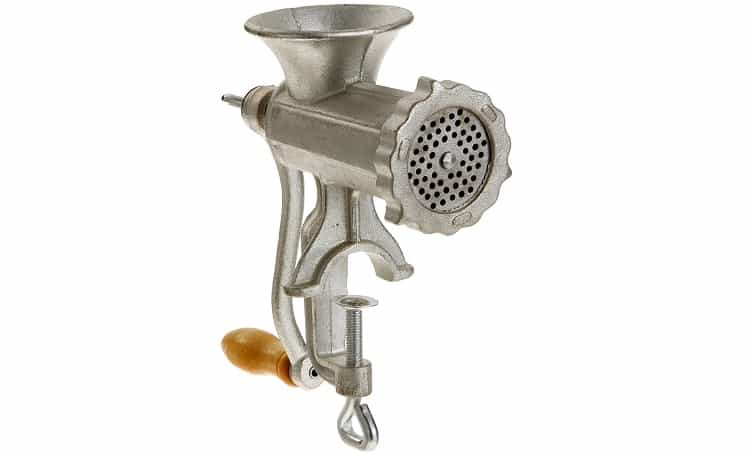
A meat grinder is also an essential component in a butcher’s shop. It is used to grind meat and fat together to make burgers, sausages, minced meat, and more. As with meat saw, there are two types of meat grinders:
- Manual meat grinders: As the name suggests, manual meat grinders must be worked on manually by rotating the lever. Though not efficient as compared to electric grinders, they are pretty cost-effective and take up less space. The CucinaPro is an inexpensive, heavy-duty meat grinder that can easily clamp onto a table and give you 3 variations of meat thickness.
- Electric meat grinders: These grinders are more efficient and faster. If you want one for your house, go for a smaller option to process up to a couple of pounds of meat. If you are planning to use one for business, then buy one to fulfill your daily requirements. The Cuisinart Electric Meat Grinder is a small yet powerful grinder that allows you to grind up to 3 pounds of chicken, beef, turkey, and venison in only a minute.
Things to Look for In Meat Grinders
Power
Power in a meat grinder translates to how many pounds of meat can be processed in a minute. So it’s best to know your meat requirements before buying a meat grinder. If you want a meat grinder for domestic use, the power will be considerably lower than a commercial meat grinder.
Grinder Plates
Different processes require different grinding plates with different diameters. A meat grinder usually comes with 2 or 3 grinder plates, but you can always purchase additional plates.
Below is a table that will help you understand what kind of meat grinder plates are used for what dishes.
| Hole Size | Grind Type and Dishes |
| 3/32” & ⅛.” | Fine Grind – Hamburgers and bologna |
| 5/32 & 3/16” | Medium Fine Grind – Sausages |
| ¼” | Medium Coarse Grind – Salami and Pepperoni |
| ⅜” | Coarse Grind – Chorizo |
| ½” & ¾.” | Very Coarse Grind – Stew Meat |
Grinder plates need to be replaced periodically as they go blunt after a while. For maximum performance, it is also recommended to change the blades in the grinder machine for the best output.
I would recommend the Cuisinart electrical grinder for daily operations. It can grind up to 3 pounds of meat per minute and is built of stainless steel for easy cleaning.
Boning Hook
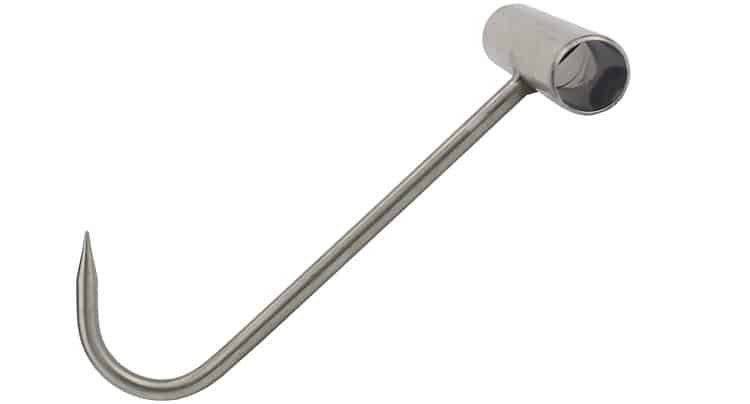
A boning hook is a hook attached to a handle to handle the animal carcass while working on it. It surely can save you from detaching your fingers, even your hand, on occasions. The boning hook is not only used for extra security, but it can also increase precision in cuts.
Gambrel

A gambrel, in simple terms, is like a hanger for hanging the carcass in the air. It is lightweight, and it helps open the animal wider for easy access. A gambrel can be used when skinning and when separating different pieces of the animal.
Safety Recommendations
There’s a lot that can go wrong in butchery. Following these safety tips and precautions will allow you to have a safe and healthy butchery experience.
- Sharpen the knives: Make sure to sharpen your knives regularly using a whetstone or steel. A blunt knife is more dangerous than a sharp knife. That’s because you will have to exert more force to cut meat with a blunt knife, and that can probably lead to accidents.
- Keep tabs on grinder plates: Periodically maintain the grinder blades, depending on how often you use the meat grinder. The plates can get blunt over time and may not work as efficiently, so make sure you routinely check on them.
- Choose a knife for beginners: Use textured steel to sharpen your knives if you are a beginner, as polished steel will damage the knife if the strokes are not precise.
- Get professional training: Make sure to be well trained before using an electric saw. Only use the electric saw under supervision till you are comfortable with your skills.
- Use a meat hook: A meat hook will help maintain a grip on the meat while using a saw or a meat cleaver. This will help you avoid any accidents or mishaps.
- Soak the whetstone: Make sure to dip the whetstone in water for 15 minutes before using it.
- Keep children away: A no-brainer, but incidents happen way too often where kids might get access to these potentially dangerous tools. Place all sharp objects away from children’s reach at an elevated spot.
Frequently Asked Questions
Question: Can the knives and the meat saw be placed in a dishwasher?
Answer: Knives made out of stainless steel are dishwasher safe, but knives made out of carbon steel should be washed by hand. Manual saws with removable saws can be cleaned in a dishwasher. The saw should go in the dishwasher separately.
Question: How to sharpen a knife?
Answer: Knives can be sharpened in a variety of ways, and it depends on which material is used to sharpen the knives. If you are using a sharpening stone, the knives should be sharpened at an angle of 10-15 degrees to achieve the best results.
If you are using steel, the knives should be moved side by side to sharpen them properly. It is advised to use textured steel if you are a beginner, as the polished steel can ruin your knife if not used properly.
Question: Which handle is preferred for a meat cleaver, wooden or metal?
Answer: Both handles work well on a meat cleaver. The metal handle is easier to maintain, whereas the wooden handle might need some care. That said, wooden handles tend to have a better grip as compared to metal handles. So it depends on user preference when it comes to choosing a handle for their meat cleaver.
Question: Which blade is better for a chef’s knife, carbon steel or stainless steel?
Answer: Both blades have their own benefits, so again, this will depend on your personal preferences. Carbon steel knives are more popular and tend to be sharper than stainless steel knives.
They cannot be cleaned using water, so they need to be wiped down after use. Stainless steel blades, on the other hand, are very easy to maintain and also dishwasher friendly.
Conclusion – Choosing the Best Butcher Tools and Meat Processing Equipment
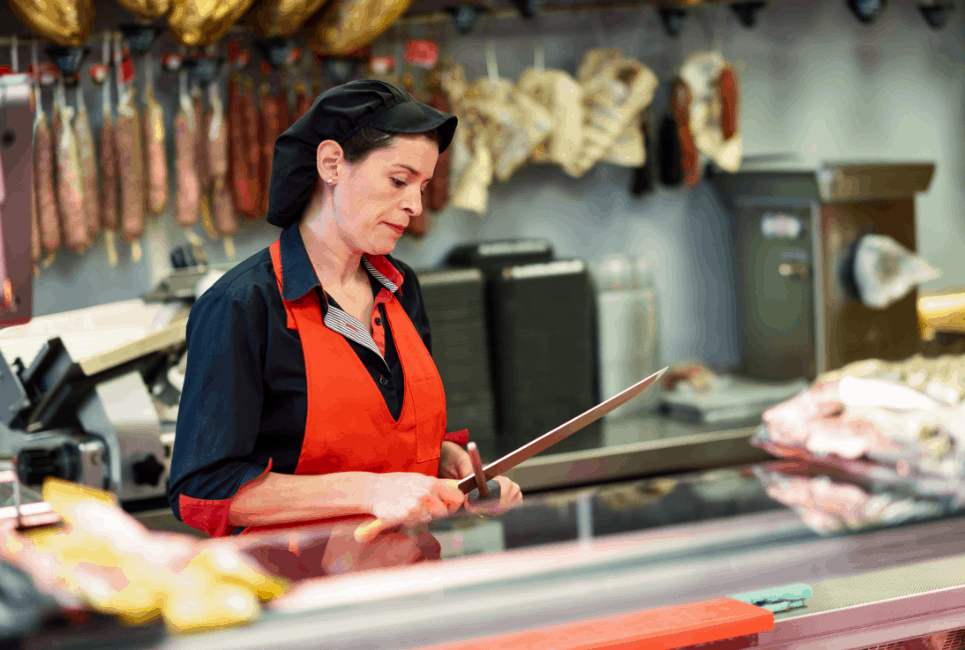
For a small DIY butchery set up at home, it is essential for you to know the skills before you buy the equipment. Without proper skills, the tools may not only be useless but potentially dangerous as you may injure yourself.
That said, butchery is one of the most acceptable trades, and every man or woman who enjoys eating meat should give it a try once in their lifetime. The equipment you choose will also dictate the type of cutting you do for the meat.
The amount and type of meat and your needs for meat cuts will determine what knives, meat saws, meat tenderizers, meat hooks, and cutting boards you will need.
If you’re just starting out and need a basic setup, you should begin with a boning knife, meat cleaver, and a manual meat grinder.
I would also suggest getting a boning hook earlier, so you’re able to perform cuts while maintaining a grip. And don’t forget the cutting board. I cannot state enough that a good cutting board will last longer and save your cleaver from damage.
At this point, I don’t think you need a tenderizer as you can use kitchen tools in your home, such as a rolling pin to smash the meat and make it soft.
I also don’t think a meat saw is necessary at this stage because it requires precision, and you would need to work on your knife skills first before moving to dissect large portions of meat. Once you’re comfortable enough using the knife and cleaver, then you can get a complete kit of tools that allow you to cut meat with precision.
If you are looking to open your own butcher shop, you will need professional-grade equipment, so manual saws and grinders just won’t cut it (pun intended).
I would recommend having experience working with knives and traditional tools before moving to the electric saws and grinders. You will also need to be trained in using the butcher machinery to use the equipment safely.
In the end, it comes down to your preference and needs. We hope this article helped you find the right butcher tools and meat processing equipment needed to get started with this craft!
Read More:
- LEM Meat Grinder Model Guide [2021]: Is It Really Good?
- Hobart Meat Slicer Review [2021]: Is It The Best Meat Processing Machine?
- Cabela’s Meat Grinder Model Guide [2021]: Is It The Best Meat Grinder?
- Rival Meat Slicer Review and Guide [2021]: Is It Worth Your Money?
- Chef’s Choice Meat Slicer Review and Guide [2021]: Is It Worth It?
- 8 Best Butcher Cutting Table Options This 2021
- Best 32 Meat Grinder Options [2021]: Which Should You Choose?
- Kitchenaid Meat Grinder Review [2021]: All You Need To Know
- Weston 22 Meat Grinder Review and Guide [2021]: Is It Worth It?
- Berkel Meat Slicer Review and Guide: Is It Worth It?
